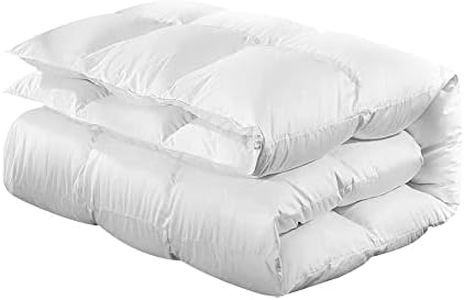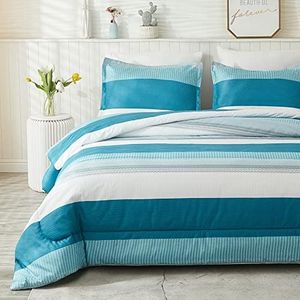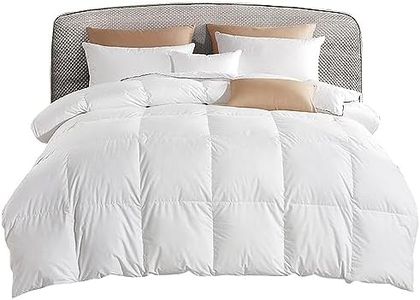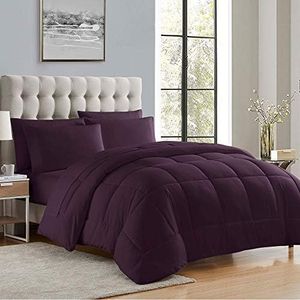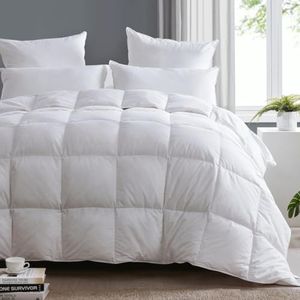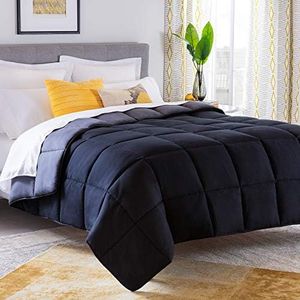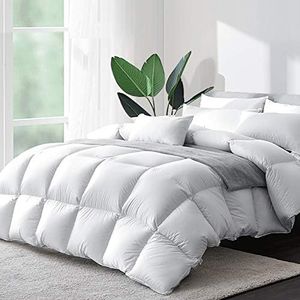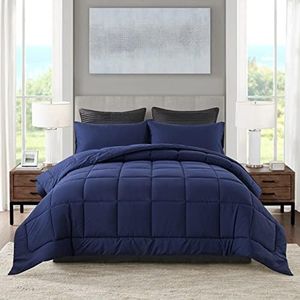We Use CookiesWe use cookies to enhance the security, performance,
functionality and for analytical and promotional activities. By continuing to browse this site you
are agreeing to our privacy policy
10 Best Down Comforters
From leading brands and best sellers available on the web.Buying Guide for the Best Down Comforters
Choosing the right down comforter can make a huge difference in the quality of your sleep, providing just the right combination of warmth, comfort, and breathability. It's important to look past just the fluffiness and pay attention to specific features that affect how the comforter will perform in your bedroom. Everyone's needs are different, whether you sleep hot, cold, or somewhere in between, and how your comforter feels and functions comes down to a few core specifications.Fill PowerFill power refers to how much space one ounce of down occupies, and it's essentially a measure of down's fluffiness and insulating ability. Higher fill power means the comforter will be lighter for the same warmth, but also fluffier and usually longer lasting. Fill power typically ranges from about 500 to over 800. If you want a warmer, fluffier comforter or live somewhere cold, aim for a higher fill power (700+). For moderate climates or if you prefer something lighter, lower fill powers (500-650) are often enough. Consider how warm you naturally sleep and the temperature in your room to decide what works best for you.
Fill WeightFill weight is the actual amount of down in the comforter, usually measured in ounces. It determines how substantial and warm the comforter will feel. Heavier fill weights provide more warmth, making them better for colder environments or if you easily get cold at night. Lighter fill weights are better if you prefer a less bulky comforter or if your room is already warm. To choose the right fill weight, think about your typical bedroom temperature and whether you tend to get hot or cold while sleeping.
Down TypeDown comes from either ducks or geese. Goose down is typically softer, fluffier, and considered a bit higher quality, while duck down tends to be more affordable and still provides good warmth. Some comforters also specify if the down comes from a specific region, but for most people, the main distinction is between duck and goose. If you're looking for luxury and ultimate fluffiness, you might prefer goose down, but for most nightly use, duck down is also a solid choice, especially if you don't have very specific needs.
Shell MaterialThe shell material is the outer fabric that holds the down inside the comforter. Common choices include cotton, microfiber, and blends. Cotton shells are breathable, durable, and soft, which helps regulate body temperature. Higher thread counts (like 300+) are softer and better at keeping the down inside without poking through. If you have sensitive skin or want something breathable, look for 100% cotton shells. If you have allergies, microfiber or tightly woven cotton might also help keep dust mites out.
ConstructionConstruction refers to how the comforter is stitched and keeps the down evenly distributed. Common designs are baffle box (which creates boxes that allow the down to loft fully and prevents shifting) and sewn-through stitching (where the top and bottom layers are sewn together, making the comforter flatter but sometimes less warm). Baffle box is ideal if you want even warmth and less clumping. Sewn-through can be sufficient if you want something lighter and don't need maximum warmth. Think about whether you want a consistently fluffy feeling or if you're fine with a flatter, more basic comforter.
Allergies / Hypoallergenic FeaturesSome people have sensitivities or allergies to down or dust mites. Many comforters are treated to be hypoallergenic, which means the down is washed more thoroughly and the shell is made to keep allergens out. If you have allergies, look for these features––they’re often highlighted on the packaging or product information. This can make your sleep more comfortable and healthier if you’re prone to sneezing or skin irritation.
Care RequirementsDown comforters vary in how easy they are to clean. Some can be machine washed, while others require dry cleaning. If you want something low-maintenance, make sure to check the care label before purchasing. If you plan to use a duvet cover and won't need to wash the comforter itself often, cleaning requirements might matter less. Think about your lifestyle and how much time or effort you want to spend maintaining your comforter.
